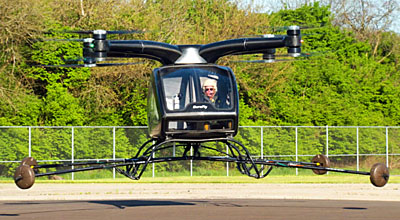
Workhorse’s SureFly octocopter takes it’s first hop fitted with “training wheels.”
What on Earth is going on in Airplane DesignerLand? Are we headed for a bifurcation, a parting of the ways among those engineering the next generation of aircraft? Perhaps. Will this affect you? How do you feel about non-fixed-wing aircraft?
I am searching for a term to generically describe these emerging flying machines; “drones” doesn’t quite do the job. More of these seemingly-weird-looking machines seem to pop up every day.
Prior experience suggests that most will never make it to market. Ones that do succeed in the eVTOL or electric-powered aircraft market may not even exist today. For that matter, it is far from certain that this will ever turn into a market, though given the huge amounts of money pouring into research projects, it seems nearly inevitable (to me) that some will survive and perhaps have a major impact on flying, both for transportation and for sport or recreation.
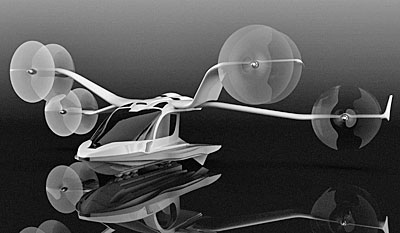
Wave eVTOL uses distributed power near the wingtips for cruise flight.
Along this vein, before and at Sun ‘n Fun 2018, I spoke to officials from BRS parachutes. They reported being intensely busy fielding requests for ballistic parachute systems from eVTOL creators. You know STOL and probably VTOL (Vertical Takeoff and Landing). EVTOL is the electric powered version of the latter and it’s a space where literally billions may be spent; many hundreds of millions already have been.
No wonder the interest in a parachute rescue system. While multicopter aircraft have the potential to be even safer than conventional aircraft with wings, that safety hinges on software robustness. Electric motors are much more reliable than combustion engines but an aircraft with no wings depends utterly on several spinning props doing their job. Developers say they can lose some and still get safely to the surface. I don’t doubt that but doing so leans heavily on highly capable software.
Remember how often your Windows computer crashed 20 years ago? No one wants that in their aircraft. However, modern computers and now tablets and smartphones rarely crash. The same sort of evolving development will likely happen to this merging of infotech and aircraft.
On April 30th, Workhorse’s SureFly octocopter (see our earlier article) took its first untethered flight. It lasted a mere 10 seconds but they’ve continued flying since. Workhorse co-founder and CEO Steve Burns said, “The first [untethered] flight proved to us what we needed to know: the energy used, the noise [level], the ease of control with the joystick, the balancing algorithms.”
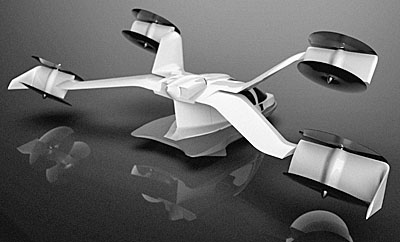
Unlike multicopters such as SureFly, Wave eVTOL “is a transitioning tilt rotor aircraft… designed to take off vertically and then transition to flight like a normal aircraft,” reports Vickers.
A piston-powered SureFly is designed to fly up to 75 miles at a speed of approximately 75 mph, with an anticipated empty weight of 1,100 pounds and a maximum takeoff weight of 1,500 pounds. A 400 pound payload seems underwhelming but these developments are at an early stage.
What happens when our current batch of deeply-experienced airplane designers get involved with this new action? Will they abandon our beloved LSA airplanes, trikes, gyroplanes, powered parachutes, and motorgliders for aircraft with multiple spinning props or pivoting wings? Maybe it’s already happening.
Enter the Wave eVTOL
“It has always been my vision to move aviation forward,” said Paul Vickers, the man and name behind New Zealand’s much-anticipated Wave LSA seaplane from Vickers Aircraft. Nearby images show what he and his team have in mind.
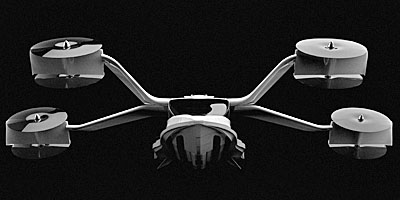
“Developing an eVTOL with amphibious capabilities opens possibilities not yet explored in this space, and with the New Zealand government leading the world from a regulation standpoint, New Zealand is on track to be the first country to allow approved manned eVTOL passenger flights.”
Vickers Aircraft is working closely with the Civil Aviation Authority of New Zealand (CAANZ) throughout the development of the Wave LSA and eVTOL aircraft variants.
As you can see yourself, the proposed Wave eVTOL uses the multicopter approach with wing sections. They aren’t the first to do this (see this article) but the Vickers’ entry has the most artistic and graceful wings I’ve seen, swooping up and out from a tailless Wave fuselage.
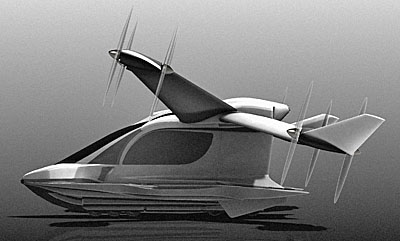
“The initial design for the Wave was always to have a core base that can be used on a number of different models; the second in this range is the Wave eVTOL,” Paul explained. “With facilities and technical ability already established [and with] wider government and regulatory support for the development of next generation aircraft in New Zealand, we feel confident in having a proof of concept ready by 2020.”
The Wave LSA seaplane will come much sooner though Vickers Aircraft is cautious about promises given what they’ve observed from other companies in this space. He offered no update on the fixed wing model.
However, he is enthusiastic about using years of hard work to bring a one-design company closer to the family of aircraft he always foresaw.
“The beauty of the Wave eVTOL is that it can be developed in parallel with [our] LSA, enabling us to maintain our schedule,” said Paul. “Both models will share everything from components and tooling to ergonomics and storage, as well as manufacturing procedures and material allowables that will combine to result in a rapid development cycle.”
To further communication on the new aircraft in planning, an organization called Sustainable Aviation Foundation will host a panel discussion called “Urban Planning for Sky Transit,” on May 12, 2018 in San Francisco, California.
For those who want to learn more about these new flying machines, see our just-released video review of most of the electric-powered aircraft at Aero Friedrichshafen. While this begins to look like an industry, this is just the beginning, I suspect. The video interviews European publisher Willi Tacke who has created a publication specifically for these eAircraft. It’s free to read online and is also offered in print form.


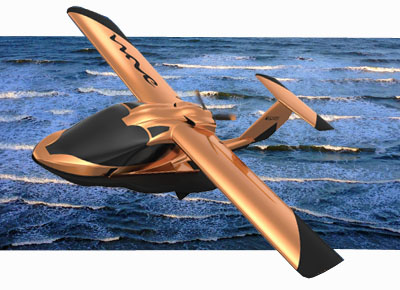
I want to be part of the revolution! How can I help Vickers?
Hi Josh: That’s easy. Reach out directly to Vickers Aircraft with your ideas.
Dan,
Another very interesting and informative article. Thank you.
Although not the focus of this article, when you mentioned that Vickers is confident of proof of concept for their eVTOL by 2020, you also mentioned that their WAVE LSA seaplane will come much sooner. Their WAVE LSA is of great interest to me and several other pilots in our area because we live in ‘lake country’, with ~1,600 lakes in the district. So amphibious LSAs would be a perfect fit.
That said, there is the Icon A5, of course, but the WAVE is proposing some significant advantages.
Unfortunately, because of their not wanting to over-promise or over-hype, Vickers appears to be keeping actual progress (or lack thereof) a secret, as their updates provide no clue as to how close they are to having wheels up with wind beneath their wings, certification, and production for sale.
The only info I have personally received from Vickers was that they would be ramping up production in 2018 without any suggestion that they had actually built a complete aircraft – let alone flown one.
As someone who is no longer a spring chicken, I likely only have a few years left to enjoy flying; so, time is of the essence!
As a knowledgeable industry insider, do you have any thoughts on the actual status of the WAVE LSA?
By the way, we live at the end of a long narrow bay, meaning significant taxi distance for takeoffs and landings. Something like the WAVE eVTOL would have a big advantage in that regard, but disadvantages not already mentioned would be lack of flight range, lack of charging infrastructure, and development would not be completed within my (flying) lifetime.
Hi Alex: I understand your enthusiasm and Wave does look highly interesting. You are right that they are keeping development close to the vest and are not taking money from people. Paul Vickers and staff were at Oshkosh 2017 and presumably will return in 2018. I would certainly check the forums to see if they will again present …if indeed they are not present with a proof of concept or better. Speaking to them directly is your very best bet. I encourage you to contact them (contact info here).
From what I see, they are entirely credible, have adequate investment funds, and appear to merely be taking the high road about not promising miracles in a short time (as too many before them have done) though I realize that does not answer your desire to know WHEN Wave will enter the market. Once it is flying — not yet to my awareness — then they have another period of proving it complies with ASTM standards. They say they are working on this in step with manufacturing design engineering and I know they have experienced staff hired from other airplane companies. Again, your best bet is direct contact.
Public records show they have requested a weight exemption (as did Icon and Terrafugia and SkyRunner… all of whom got such), so perhaps that explains the lack of more visible results to date. Few methods stimulate interest more than a mystery but pilots like yourself have a limit to how long they will wait. That’s understandable.
Thanks Dan. I have been in contact with them on a number of occasions, but the only (possibly real) info they have provided is that they are gearing up for production in 2018.
I agree with you that others have over-promised and I respect Vickers for not doing so, but providing info on milestones achieved would not be over-promising. At this stage we do not even know how close they are to having one fully assembled with controls tested – let alone having one in the air. There are no photos of even a partially assembled aircraft and I have seen nothing of the cockpit design, seating, etc.
As a result, I can only presume the WAVE will not be available within my flying lifetime. It’s a pity as this style of aircraft is perfect for my requirements and if, somehow, they manage to achieve good flight characteristics along with their proposed features and capabilities at their proposed pricing, it could be a real winner!
I recall your interview with Paul Vickers wherein you mentioned looking forward to flying one. If you ever do, I will be very interested in your report – especially as to how it compares with the A5.
Thanks again for this and all of your articles, videos and comments.
“Airplane DesignerLand” is a good phrase! Everyone wants to get in on the act. What no one fully realizes is that extra design weight matters and the short battery life hurts. Safety is also overlooked. When the power fails – where is the wing area, forward speed or counter-rotation needed for a safe landing? At least some are considering parachutes. Don’t we already have helicopter transportation? How many use that service in the private sector? But maybe a helo ride will look cheap when compared to these new devices! Imagineers many times forget to answer the most important questions first – like – Why? Is it rational to build without a reason or useful purpose?
At least we have solved the solution to using electric for cross country flight with a light weight onboard charging system used on a motor glider.